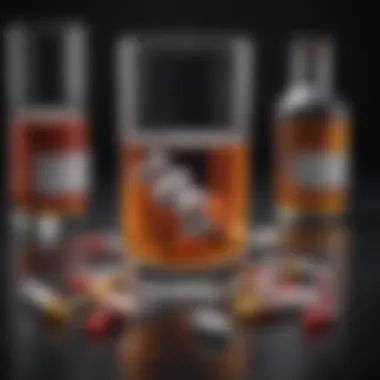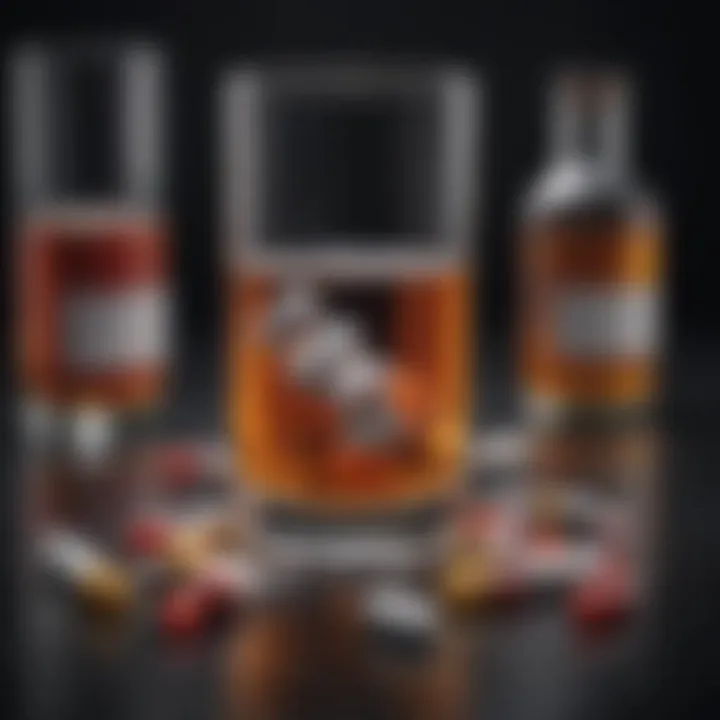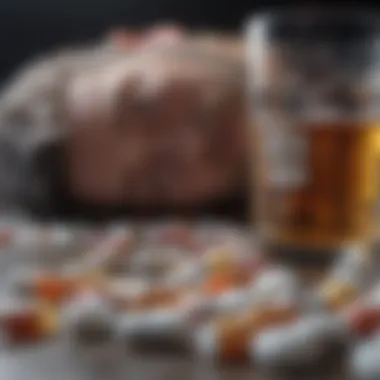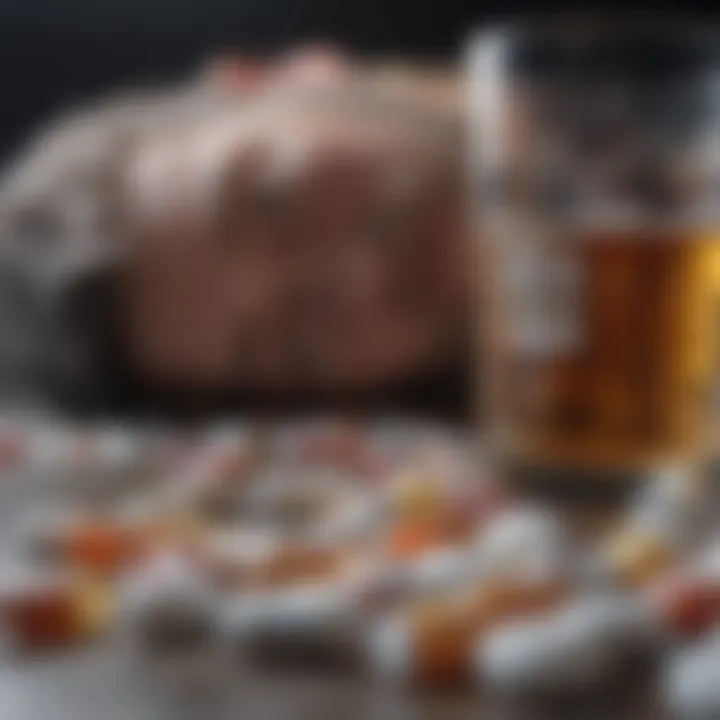Medications to Curb Alcohol Cravings: A Deep Dive


Intro
The challenges associated with alcohol cravings are significant and have a profound impact on individuals struggling with alcohol use disorder. Understanding how medication can mitigate these cravings is crucial. This section highlights essential topics such as the different types of medications available, their effectiveness, mechanisms of action, and integration with other treatment strategies. By evaluating these factors, readers can gain insights into how medication can play a role in the journey to sobriety.
Research Overview
Summary of Key Findings
Several studies have illuminated the effectiveness of pharmacological interventions in reducing alcohol cravings. Notable medications such as Naltrexone, Acamprosate, and Disulfiram have shown varying levels of efficacy. For example, Naltrexone has been observed to reduce the pleasure associated with alcohol, leading to decreased consumption. Acamprosate appears to stabilize the brain's chemical balance, helping individuals maintain sobriety. Disulfiram, on the other hand, causes unpleasant reactions when alcohol is consumed, serving as a deterrent.
Relevance to Current Scientific Discussions
The conversation surrounding alcohol cravings and their treatment continues to evolve. Current research emphasizes not only the biological underpinnings of alcohol use disorder but also the need for a multifaceted treatment approach. This encompasses behavioral therapies alongside medication management, reinforcing the idea that addressing cravings requires a comprehensive strategy.
Methodology
Research Design and Approach
Research has often utilized randomized controlled trials to assess the efficacy of medications for alcohol cravings. These studies compare the active medications against placebos, allowing for a clear understanding of their impact.
Data Collection and Analysis Techniques
Data collection typically involves clinical assessments, self-report questionnaires, and biochemical measures of alcohol consumption. Analysis methods include statistical evaluations, ensuring the accuracy and relevancy of the findings.
Ultimately, keeping abreast of the contemporary scientific landscape is vital for understanding the role of medication in managing alcohol cravings. This overview serves to equip individuals with knowledge and insights into their treatment options.
Intro
The topic of reducing alcohol cravings is significant for individuals seeking recovery from alcohol use disorder. This article will outline various medications available for this purpose, shedding light on their mechanisms, effectiveness, and side effects. Alcohol cravings can be overwhelming and are a major barrier for many trying to achieve sobriety. Therefore, understanding these medications can be crucial in formulating a well-rounded treatment plan.
Alcohol use disorder is multifaceted, requiring both medical and psychological strategies for effective treatment. Medications can serve as an important tool in this process. They may help to alleviate cravings, which in turn can make it easier for individuals to abstain or limit their alcohol intake. By integrating these pharmacological options with behavioral therapies and healthy lifestyle changes, the chances of sustained recovery may improve.
This article not only discusses the significance of medications but also emphasizes the need for tailored treatments. Each person's relationship with alcohol is unique, and therefore, strategies must be personalized. Medications can vary in effectiveness in different individuals, making it essential to consider personal history, biology, and psychosocial factors when selecting a treatment route.
Understanding the role of medication is vital. It allows patients to take a more proactive role in their recovery journey, maximizing their chances for long-term sobriety.
Taking a closer look at alcohol cravings and how medications work is essential for anyone involved in treatment plans. Readers can gain insights into therapies that integrate medication and support systems which can lead to better recovery outcomes.
Overview of Alcohol Use Disorder
Understanding alcohol use disorder (AUD) is crucial for developing effective medication strategies for reducing alcohol cravings. This condition is complex and multifaceted, encompassing various behavioral and psychological aspects. The impact of AUD extends beyond the individual, affecting family, social networks, and community structures. Therefore, a comprehensive grasp of AUD helps elucidate how pharmacological interventions can be integrated into broader treatment plans.
Definition and Diagnostic Criteria
Alcohol use disorder is characterized by an inability to control the consumption of alcohol, leading to significant impairment or distress. The Diagnostic and Statistical Manual of Mental Disorders, Fifth Edition (DSM-5) outlines specific criteria for diagnosing AUD, including:
- Consuming alcohol in larger amounts or for a longer period than intended.
- Unsuccessful efforts to cut down or control alcohol use.
- Spending a large amount of time obtaining, using, or recovering from alcohol.
- Experiencing cravings or strong desires to use alcohol.
- Failing to fulfill major obligations at work, school, or home due to alcohol use.
- Continuing to use alcohol despite persistent social or interpersonal problems.
- Developing tolerance or needing more alcohol to achieve the desired effect.
- Experiencing withdrawal symptoms when not drinking.
The presence of these criteria can greatly influence treatment options and the specific medications chosen to assist in reducing cravings.
Prevalence and Impact on Society
The prevalence of alcohol use disorder is significant, impacting millions globally. According to the World Health Organization, more than 5% of the world's population suffers from AUD. In the United States alone, alcohol use disorder affects over 14 million adults every year. This prevalence has profound implications:
- Health Consequences: AUD is linked to a variety of health issues, including liver disease, cardiovascular problems, and increased risk of various cancers.
- Economic Burden: The financial toll of AUD includes healthcare costs, loss of productivity, and legal issues, amounting to over $249 billion annually in the U.S. alone.
- Social Impact: Families and communities suffer from the effects of AUD, which can lead to increased violence, disrupted relationships, and challenges in social cohesion.
Understanding these dimensions aids in recognizing the necessity for comprehensive treatment approaches that include medication, therapy, and community support. Each of these elements plays a key role in addressing not just the symptoms, but also the root causes of alcohol cravings in individuals diagnosed with AUD.


Pharmacological Approaches to Alcohol Cravings
Pharmacological approaches to reducing alcohol cravings are an essential component of treatment for alcohol use disorder. These medications serve various functions, from decreasing the desire to drink to minimizing withdrawal symptoms. Their importance lies in providing individuals with additional tools for managing cravings that accompany recovery. Understanding how these medications work, their effectiveness, and how they integrate with other treatment modalities is necessary for comprehensive care.
Types of Medications Available
Acamprosate
Acamprosate is a medication designed specifically for treating alcohol dependence. This drug is known for its role in restoring the balance of neurotransmitters disrupted by chronic alcohol consumption. One key characteristic of Acamprosate is that it helps reduce cravings, making it beneficial for individuals after detoxification. This medication is often preferred for patients who have a strong urge to drink in recovery.
Its unique feature lies in its mechanism of action, which is thought to involve the modulation of glutamate and gamma-aminobutyric acid (GABA) neurotransmission. People might find this medication advantageous because it can be taken long-term without leading to dependency. One disadvantage could be the need for strict adherence to a treatment regimen, as missing doses may decrease its effectiveness.
Naltrexone
Naltrexone is another medication that has gained popularity in treating alcohol cravings. It acts as an opioid antagonist, blocking the euphoric effects produced by alcohol consumption. A key characteristic of Naltrexone is its ability to reduce the reinforcing effects of alcohol, thereby decreasing the likelihood of relapse.
One significant advantage of Naltrexone is its convenience; it can be taken orally or as an extended-release injection, providing flexibility. However, the administration of Naltrexone comes with some considerations, such as potential liver toxicity, which necessitates regular monitoring during treatment. Additionally, it may not be suitable for individuals who are still consuming alcohol or are opioid dependent.
Disulfiram
Disulfiram works differently by inhibiting the enzyme involved in metabolizing alcohol. When someone consumes alcohol while on Disulfiram, they experience unpleasant symptoms, creating a deterrent effect. This mechanism can be particularly effective for motivated individuals looking to cease alcohol consumption entirely.
A notable characteristic of Disulfiram is that its effectiveness depends significantly on patient compliance and motivation. While it can be a beneficial option for some, the fear of experiencing severe reactions can be anxiety-inducing. Its unique feature is the instant consequences it creates when alcohol is consumed, serving as a powerful reminder of the risks associated with drinking. However, it puts users at risk if not fully understood, hence education surrounding its usage is critical.
Mechanisms of Action
Understanding the mechanisms of action for these medications provides deeper insight into their effectiveness.
Acamprosate works by stabilizing the chemical imbalance caused by alcohol abuse. It is thought to reduce cravings by influencing the glutamatergic system, which can be overactive in individuals with alcohol use disorder.
Naltrexone blocks brain receptors associated with the pleasurable effects of alcohol. This antagonistic effect diminishes the reinforcement associated with drinking, making it less appealing.
Disulfiram operates by causing adverse reactions when alcohol is consumed, which serves as a behavioral reinforcer against drinking. Each medication caters to different aspects of alcohol dependency, offering a spectrum of options for individuals struggling with cravings.
Effectiveness of Medications
The effectiveness of medications in reducing alcohol cravings plays a crucial role in the treatment of alcohol use disorder. Effective treatment enhances the overall recovery process and can lead to better patient outcomes. Medications can help in managing cravings, making it easier for individuals to resist the urge to drink. This is particularly important because alcohol dependence can be complex, influenced by both biological and psychological factors.
When evaluating the effectiveness of these medications, it is essential to look at clinical studies and their outcomes. Studies reveal that medications, such as Acamprosate and Naltrexone, can significantly influence the trajectory of recovery. Understanding how these medications work and their success rates can provide insight into their role in managing alcohol cravings.
Clinical Studies and Outcomes
Numerous clinical studies have explored the effectiveness of medications in reducing alcohol cravings. For instance, Naltrexone has shown positive effects in several trials, leading to a reduction in the frequency of heavy drinking days. A meta-analysis indicated that individuals taking Naltrexone were more likely to sustain abstinence compared to those not on medication.
On the other hand, Acamprosate has been effective in maintaining abstinence post-detoxification. Research has shown that it can help restore the balance of neurotransmitters in the brain, aiding individuals in managing their cravings. In randomized clinical trials, participants reported a lesser desire to drink when using Acamprosate compared to a placebo. This suggests a noteworthy benefit in maintaining sobriety.
"Medications like Naltrexone and Acamprosate do not simply target alcohol cravings; they reshape the recovery process, offering tools for hope and stability."
The outcomes of such studies are vital, as they guide clinicians in prescribing the appropriate medication based on individual needs. Long-term follow-up studies reveal that sustained use of these medications improves overall recovery rates.
Comparative Effectiveness of Different Medications
When considering effectiveness, it is important to compare the different medications available. Naltrexone and Acamprosate, for example, both target cravings but through different mechanisms.
- Naltrexone: Primarily functions as an opioid receptor antagonist, which can reduce the rewarding effects of alcohol, making drinking less appealing. It is often prescribed for clients who have a history of consuming large quantities of alcohol.
- Acamprosate: Works on the glutamate system, aiming to correct the chemical imbalance that occurs with alcohol dependence. It is more effective for those who have recently stopped drinking and want to maintain abstinence.
- Disulfiram: While not focused solely on cravings, it creates an unpleasant reaction when alcohol is consumed, serving as a deterrent for drinking.
Different individuals may respond variably to these medications due to genetic factors, personal history, and the severity of their disorder. Therefore, a comparative analysis is critical in tailoring the treatment plans, ensuring that those struggling with alcohol cravings receive the medication that aligns best with their recovery goals.


Side Effects and Considerations
Understanding the side effects and considerations of medications for reducing alcohol cravings is crucial for both individuals seeking treatment and healthcare professionals guiding them. Awareness of these aspects can lead to better management of expectations and outcomes. It highlights the balance between the benefits of medications and their possible adverse effects.
When medications are prescribed, it is vital to consider not only their effectiveness but also how they fit into the overall recovery process. This leads to informed decisions about which treatments to pursue and can enhance the chances of long-term sobriety while minimizing potential harm.
Common Side Effects of Medications
Many medications used to treat alcohol cravings have associated side effects. These can vary in intensity and impact based on individual reactions. Common side effects can include:
- Nausea: This may result from the adjustment to medication, potentially leading some to discontinue use prematurely.
- Fatigue: Many patients report feeling unusually tired. This could affect daily activities and overall quality of life.
- Headaches: These can arise from different medications and can be bothersome.
- Dizziness: Some users may experience dizziness or lightheadedness, affecting their ability to function.
- Mood Changes: Alterations in emotional state are also reported. This may complicate the recovery process if not addressed adequately.
It is important that individuals communicate these side effects with their healthcare provider. This dialogue can help in adjusting medications or dosages for better tolerance and effectiveness.
Long-term Implications of Medication Use
Using medications to reduce alcohol cravings can have long-term implications. While the goal is to sustain sobriety, there can be unintended effects to consider over time. Some points to think about include:
- Dependency: Relying on medication may create a sense of dependency that overshadows the core issue of alcohol use disorder.
- Tolerance: Over time, individuals may require higher dosages to achieve the same effect, which can lead to increased side effects or complications.
- Withdrawal Symptoms: Stopping medication suddenly can lead to withdrawal symptoms, complicating the recovery journey.
- Psychosocial Factors: Long-term use of medications may not address underlying psychological or social issues relevant to alcohol abuse.
In summary, while medications can greatly assist in managing alcohol cravings, their side effects and long-term implications should be critically assessed to form a comprehensive and effective treatment plan. A thoughtful, individualized approach helps to integrate these considerations into the broader context of recovery.
Integration of Medications with Therapy
In the context of alcohol use disorder treatment, integrating medications with therapeutic approaches enhances effectiveness. This strategy acknowledges the multifaceted nature of addiction, which often entails psychological triggers and social circumstances in addition to biological factors. Medications can help in reducing cravings and withdrawal symptoms, but their efficacy significantly increases when coupled with behavioral therapy and support groups. A comprehensive treatment plan can lead to sustained sobriety and improved overall well-being.
Behavioral Therapies
Behavioral therapies are vital in reducing alcohol cravings by addressing underlying psychological issues and reinforcing positive behaviors. Techniques such as cognitive-behavioral therapy (CBT) focus on identifying and modifying thought patterns that contribute to drinking. This therapy fosters coping strategies that can help individuals handle triggers effectively.
Additionally, motivational interviewing can enhance patients' motivation to change, ensuring they are more engaged in their recovery process. The use of these therapies alongside medications like Naltrexone helps fortify individuals against the compulsion to drink, making them less reliant solely on pharmacological interventions.
Research indicates that patients who undergo behavioral therapies while using medications have better outcomes. They tend to adhere to their treatment plans more consistently, leading to a reduction in relapse rates and promoting long-term recovery.
Support Groups and Their Role
Support groups play an essential role in the holistic treatment of alcohol use disorder. Organizations such as Alcoholics Anonymous (AA) offer a platform for individuals to share their experiences, struggles, and successes. These groups create a sense of community and belonging, reducing isolation, which is often a significant contributor to alcohol cravings.
Moreover, combining support groups with medications cultivates accountability. Participants encourage one another to remain on their prescribed medication plans while actively participating in group meetings. This integration reinforces the notion that recovery is a shared journey rather than a solitary endeavor.
Thus, the synergy between medications and therapy components strengthens the recovery framework. Each element complements the others, ultimately leading toward more effective treatment outcomes. Understanding this relationship is fundamental for anyone engaged in managing alcohol use disorder.
"A comprehensive approach that combines medication, therapy, and peer support leads to sustainable recovery paths." - Expert in Addiction Treatment
The Role of Lifestyle Changes
The role of lifestyle changes in addressing alcohol cravings cannot be overstated. While medications can assist in reducing cravings, the integration of lifestyle modifications offers a holistic approach to recovery. This aspect is essential because it addresses the root causes of alcohol dependence and enhances the efficacy of pharmacological treatments. Lifestyle changes, including dietary adjustments and increased physical activity, can promote overall well-being and better mental health, which is beneficial for individuals recovering from alcohol use disorder.
Dietary Considerations
Diet plays a crucial role in managing alcohol cravings. Eating a balanced diet helps stabilize mood and energy levels. Nutrient-rich foods can counteract the deficiencies often caused by alcohol consumption. For example, foods high in omega-3 fatty acids, such as salmon and flaxseeds, may improve brain function and mood regulation.
In addition, certain vitamins and minerals, like B vitamins and magnesium, are important for neurological health. Consumption of whole grains, fruits, and vegetables not only supports physical health but also fosters psychological resilience.
Moreover, abstaining from refined sugars and processed foods can reduce cravings. This is because simple carbohydrates can lead to spikes and subsequent crashes in blood sugar levels, which may trigger further cravings for alcohol.
Physical Activity and Recovery


Physical activity is another significant component of lifestyle changes. Engaging in regular exercise has been shown to enhance mood and reduce stress, factors that often contribute to cravings for alcohol. Exercise boosts the release of endorphins and serotonin, contributing to a sense of well-being.
Additionally, exercise can serve as a positive outlet for stress and emotions that may otherwise lead to relapse. Activities such as running, swimming, or even yoga can provide both physical and mental benefits. Maintaining a consistent workout routine also reinforces discipline, which can translate to other areas of recovery.
Incorporating physical activity into daily routines should be gradual and enjoyable. Finding activities that individuals genuinely enjoy can encourage long-term adherence. Group activities can also foster social connections, which are critical in replacing the social aspects of drinking.
Lifestyle changes such as dietary improvements and increased physical activity are vital in managing alcohol cravings and supporting long-term recovery. By focusing on these areas, individuals can improve their overall health and resilience against cravings.
In summary, the role of lifestyle changes is quintessential in the journey toward reducing alcohol cravings. Through nutritional adjustments and the incorporation of regular physical activity, individuals can cultivate an environment that supports both physical and psychological recovery.
Personalized Treatment Approaches
Personalized treatment approaches are essential when dealing with the complexities of alcohol cravings and Alcohol Use Disorder (AUD). These strategies focus on the individual’s unique characteristics, shaping the treatment methods to better align with each person's needs. The effectiveness of medication for alcohol cravings can vary significantly from one individual to another due to several factors. Understanding these personalized elements not only enhances the efficacy of treatment but also supports the individual's journey toward recovery.
Personalization entails adapting the intervention methods to the patient. This includes considering biological, psychological, and social factors that influence how an individual responds to medications. By tailoring treatment, healthcare professionals can maximize the likelihood of successful outcomes, minimize side effects, and improve the overall quality of life for the patient. For instance, someone with a specific genetic makeup may respond better to one medication over another. This tailored approach helps in reducing alcohol cravings more effectively than a one-size-fits-all method.
Factors Influencing Medication Response
Several factors influence how an individual responds to medication in the context of reducing alcohol cravings. These can include:
- Genetic Factors: Individual genetic differences can impact the metabolism and efficacy of drugs.
- Biochemical Variations: Body chemistry plays a crucial role in medication response.
- Psychological State: Mental health conditions, such as depression or anxiety, may affect treatment outcomes.
- Co-occurring Conditions: Other health issues can complicate the effectiveness of certain treatments.
- Substance Use History: Previous history with different substances may also provide insights into which medication might be more suitable.
By recognizing these factors, healthcare providers can make informed decisions about which medications might work best for each patient.
Tailoring Treatment to Individual Needs
Tailoring treatment to individual needs is about understanding the specific circumstances and characteristics of the person in recovery. It is crucial to assess not only the biological aspects but also the psychological, social, and environmental influences that come into play.
- Assessment and Diagnosis: Comprehensive evaluations help in identifying the most appropriate medication. This involves testing for other disorders that could affect recovery.
- Ongoing Monitoring: Continuous assessment throughout the treatment process helps in making timely adjustments to medication types or dosages.
- Incorporating Lifestyle Factors: Individual preferences regarding lifestyle can also dictate the choice of therapy. Fatigue from medication, dietary restrictions, or physical activity levels can all factor into how effective a treatment might be.
- Support System: A stable support system is critical. Recovery often includes considering the patient's social environment and relationships.
Ultimately, personalizing treatment can lead to a more sustainable and satisfying recovery process. A focus on specific needs creates a sense of ownership and motivation in patients, further boosting their potential for overcoming alcohol cravings.
Future Directions in Research
Research into medications for reducing alcohol cravings is advancing. This area is critical because it offers the potential to improve the quality of life for those with alcohol use disorder. Several elements illustrate the significance of ongoing research in this field.
One of the most significant benefits is the exploration of emerging medications. These could provide new options for individuals who do not respond well to existing treatments or experience intolerable side effects. Improving the options available is vital for customization of treatment plans, which can lead to better adherence and outcomes.
Considerations about future research include understanding the genetic variability in responses to medications. Personalized medicine is becoming increasingly important in healthcare. Researchers are investigating how genetic factors influence medication efficacy. This knowledge may help clinicians tailor treatment plans to individual patients, thereby increasing the likelihood of successful outcomes.
"Emerging research focuses on understanding unique patient needs to create custom medication regimens that enhance recovery."
Additionally, there is a focus on the integration of pharmacological and psychosocial therapies. Evidence suggests that a combined approach may yield better results than medication or therapy alone. Researching how these treatments can work together helps refine treatment protocols.
Continuous evaluation of the long-term effects of medications is also critical. Many current medications are effective in the short term, but less is known about their sustainability over time. Future studies might explore comprehensive monitoring of patients using these medications to map out long-term impact and optimize dosage frameworks.
Finally, public health implications are a core concern. Research must prioritize understanding the social factors that influence alcohol use and treatment accessibility. Identifying and addressing barriers to treatment can enhance the reach and effectiveness of new medication options. Thus, fostering an environment where evidence-based treatments are available and accessible is necessary for significant health improvements in the population.
Closure
The conclusion of this article is vital in synthesizing the variety of information discussed regarding medications for reducing alcohol cravings. This section encapsulates key findings, stresses the importance of personalized treatment approaches, and asserts the overall benefits these medications can bring to individuals battling alcohol use disorder. In the realm of alcohol cravings and their management, understanding the interplay between medication and individual needs is crucial.
Summary of Key Points
In summary, medications like Acamprosate, Naltrexone, and Disulfiram play a significant role in treating alcohol dependence. Each medication operates through different mechanisms, targeting unique aspects of alcohol cravings. Clinical research supports their effectiveness, although responses can vary widely due to individual characteristics. Additionally, the integration of these medications with therapeutic interventions and lifestyle changes often yields better recovery outcomes.
- Acamprosate helps stabilize chemical balance in the brain.
- Naltrexone reduces the rewarding effects of alcohol.
- Disulfiram creates unpleasant reactions when alcohol is consumed.
Importantly, combining medical treatments with behavioral therapies enhances sustained recovery and decreases relapse risk.
Encouragement for Seeking Help
For individuals struggling with alcohol cravings, seeking help is an essential step towards recovery. Not only can medications alleviate the intensity of cravings, but they also serve as a foundation for a more extensive treatment plan incorporating psychological and lifestyle support. It is essential to recognize that recovery is a process that involves collaboration between healthcare providers and the individual. Personalized treatment plans tailored to an individual's specific needs can significantly improve the odds of successfully managing alcohol cravings and attaining long-term sobriety.



